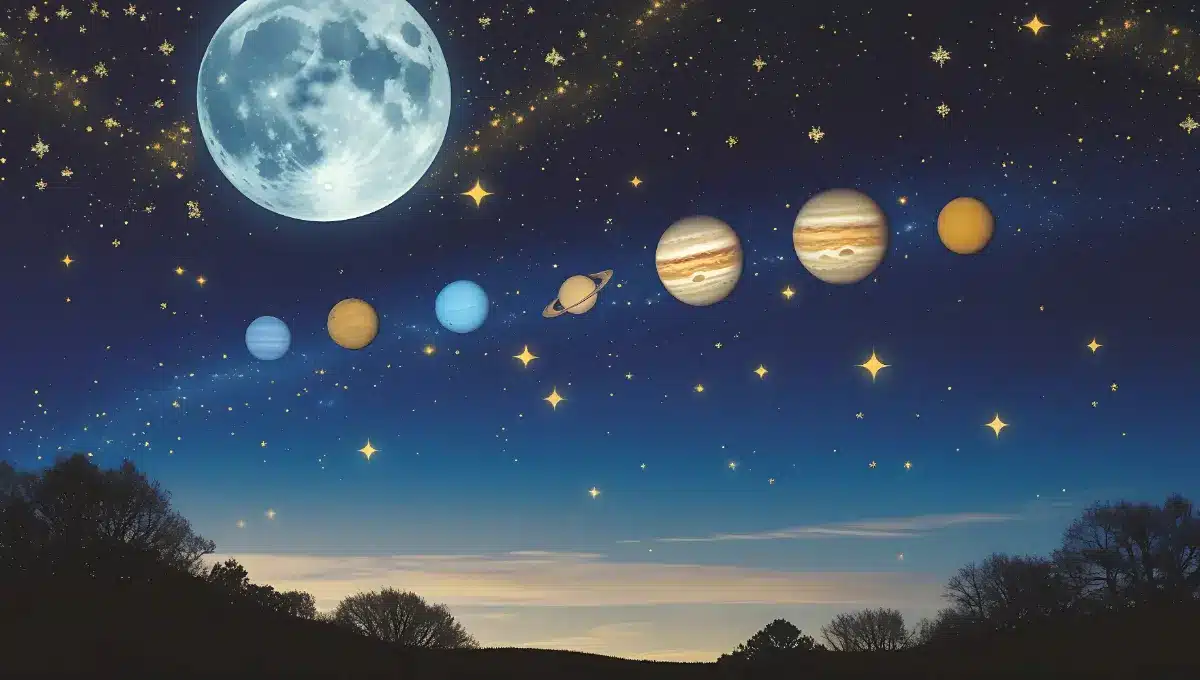Did you know February’s night sky is packed with cosmic events you can’t miss? From a rare 7-planet parade to the glowing Snow Moon and Venus shining brighter than ever on Valentine’s Day, this month is a stargazer’s dream.
Last year, I missed the planet parade because I didn’t know when to look—don’t make the same mistake!
Here’s your guide to February’s celestial highlights, so you can plan your stargazing nights like a pro.
 1. Feb. 1: Moon Meets Venus and Saturn
1. Feb. 1: Moon Meets Venus and Saturn

What to expect: A delicate crescent moon hangs near bright Venus, with Saturn glowing faintly below. according to Stellarium.
- Best time to watch: Right after sunset, southwest sky.
- Pro tip: Use binoculars to spot Saturn’s rings—it’s worth the effort!
2. Feb. 6: Moon and Jupiter Dance Together
What to expect: The moon pairs up with Jupiter, the solar system’s largest planet. Mars will also be nearby, adding a reddish glow.
- Best time to watch: Evening, southern sky.
- Fun fact: Jupiter’s four largest moons are visible with binoculars—look for tiny dots around the planet.
Also Read: February Night Sky Spectacles: A 7-Planet Parade, Snow Moon, and Venus’ Valentine’s Surprise!
3. Feb. 9: Mars and Moon Pair Up
What to expect: A nearly full moon shines close to Mars, creating a stunning contrast between the moon’s white glow and Mars’ reddish hue.
- Best time to watch: All night, southwest sky.
- Pro tip: Use a telescope to see Mars’ surface details, like its polar ice caps.
4. Feb. 12: Full Snow Moon
What to expect: The second full moon of the year, named for February’s heavy snowfall, will light up the night. according to Astronomy.com
- Best time to watch: Evening of Feb. 11–12, near the horizon.
- Why it’s special: The moon illusion makes it appear larger and brighter when it’s low in the sky.
5. Feb. 14: Venus at Its Brightest (Valentine’s Surprise!)
What to expect: Venus, the brightest planet, will shine even more brilliantly—perfect for a romantic stargazing date, According to EarthSky.
- Best time to watch: Evening, western sky after sunset.
- Fun fact: Venus won’t be this bright again until September 2026, so don’t miss it!
6. Feb. 28: Seven-Planet Parade
What to expect: All seven planets (Mercury, Venus, Mars, Jupiter, Saturn, Uranus, and Neptune) will be visible in the night sky at once.
- Best time to watch: Just after sunset, western horizon.
- Pro tips:
- Mercury and Saturn will be low on the horizon—find a spot with a clear western view.
- Use a telescope to spot Uranus and Neptune.
- Follow the arc from Mercury and Saturn up to Venus, Jupiter, and Mars.
Stargazing Tips for February
- Find a dark spot: Light pollution can hide fainter planets. Use apps like Dark Sky Finder to locate the best viewing areas.
- Bring binoculars or a telescope: While most planets are visible to the naked eye, binoculars or a telescope will enhance your experience.
- Dress warmly: February nights can be chilly, especially if you’re staying out for hours.
- Check the weather: Clear skies are essential for stargazing. Use apps like Clear Sky Chart to plan your nights.
Final Tip:
Mark your calendar for Feb. 28—the 7-planet parade is a rare event you won’t want to miss. Grab a blanket, some hot cocoa, and enjoy the show!
FAQs
Q. Can I see the 7-planet parade without a telescope?
A. Yes! Mercury, Venus, Mars, Jupiter, and Saturn are visible to the naked eye. Uranus and Neptune need a telescope.
Q. What if I miss Venus on Valentine’s Day?
A. Don’t worry—it’ll still be bright for a few days after. But Feb. 14 is the peak!
You’re wasting your Netflix Subscription: If you haven’t watched these 14 must watch movies.
Florida Panthers Stanley Cup Victory Parade 2025: Everything You Need to Know


